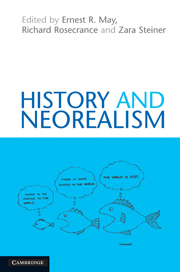Book contents
- Frontmatter
- Contents
- List of tables
- Notes on contributors
- Acknowledgments
- 1 Theory and international history
- 2 Transformations in power
- 3 Domestically driven deviations: internal regimes, leaders, and realism's power line
- 4 How international institutions affect outcomes
- 5 Not even for the seventeenth and eighteenth centuries: power and order in the early modern era
- 6 Austria-Hungary and the coming of the First World War
- 7 British decisions for peace and war 1938–1939: the rise and fall of realism
- 8 Realism and risk in 1938: German foreign policy and the Munich Crisis
- 9 Domestic politics, interservice impasse, and Japan's decisions for war
- 10 Military audacity: Mao Zedong, Liu Shaoqi, and China's adventure in Korea
- 11 The United States' underuse of military power
- 12 The overuse of American power
- 13 Redrawing the Soviet power line: Gorbachev and the end of the Cold War
- 14 Shared sovereignty in the European Union: Germany's economic governance
- 15 John Mearsheimer's “elementary geometry of power”: Euclidean moment or an intellectual blind alley?
- 16 History and neorealism reconsidered
- Index
1 - Theory and international history
Published online by Cambridge University Press: 05 June 2012
- Frontmatter
- Contents
- List of tables
- Notes on contributors
- Acknowledgments
- 1 Theory and international history
- 2 Transformations in power
- 3 Domestically driven deviations: internal regimes, leaders, and realism's power line
- 4 How international institutions affect outcomes
- 5 Not even for the seventeenth and eighteenth centuries: power and order in the early modern era
- 6 Austria-Hungary and the coming of the First World War
- 7 British decisions for peace and war 1938–1939: the rise and fall of realism
- 8 Realism and risk in 1938: German foreign policy and the Munich Crisis
- 9 Domestic politics, interservice impasse, and Japan's decisions for war
- 10 Military audacity: Mao Zedong, Liu Shaoqi, and China's adventure in Korea
- 11 The United States' underuse of military power
- 12 The overuse of American power
- 13 Redrawing the Soviet power line: Gorbachev and the end of the Cold War
- 14 Shared sovereignty in the European Union: Germany's economic governance
- 15 John Mearsheimer's “elementary geometry of power”: Euclidean moment or an intellectual blind alley?
- 16 History and neorealism reconsidered
- Index
Summary
Introduction
When a major power acts aggressively and unpredictably, opponents often are nonplussed. The targets of aggressive action first interpret the move as a deliberate challenge, and are tempted to adopt an offensive response. But, they hesitate to respond until they understand why the opponent felt impelled to issue the challenge. Chairman Nikita Khrushchev of the Soviet Union placed “offensive” missiles in Cuba, although President John F. Kennedy had explicitly warned him not to do so. When the missiles were detected and the president informed on October 16, 1962, JFK reacted explosively. “He can't do this to me,” Kennedy said (in more graphic terms than reproduced here). Kennedy's advisers initially interpreted Khrushchev's move as a completely illegitimate and unparalleled action in terms of Soviet foreign policy. No Soviet leader had ever placed such missiles in the Eastern European satellite countries – how could they station them ninety miles off the coast of the United States? From Khrushchev's point of view, however, while the placement was abrupt and unprecedented, it was also a symmetrical response to American stationing of Jupiter missiles in Turkey near the southern border of the Soviet Union. The Soviet missiles were also sent in reaction to US threats to Cuba which were even more compelling than any Russian pressure on Turkey. “What was sauce for the goose was sauce for the gander,” Khrushchev reasoned.
- Type
- Chapter
- Information
- History and Neorealism , pp. 1 - 7Publisher: Cambridge University PressPrint publication year: 2010



